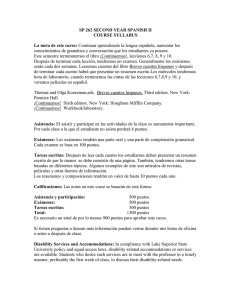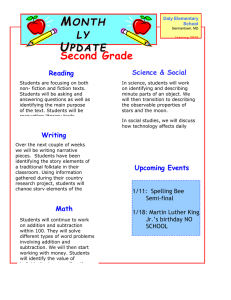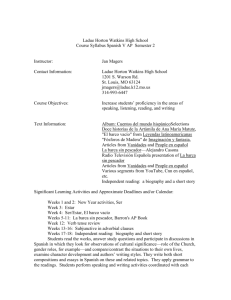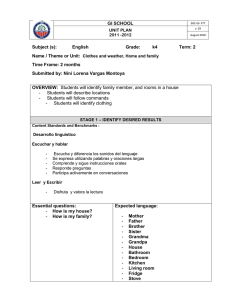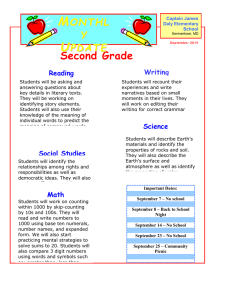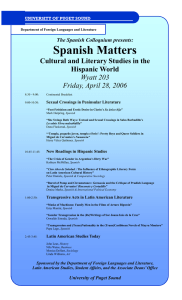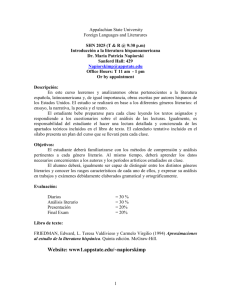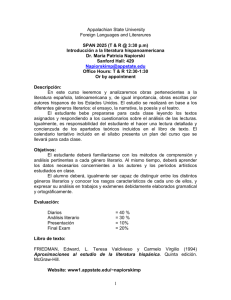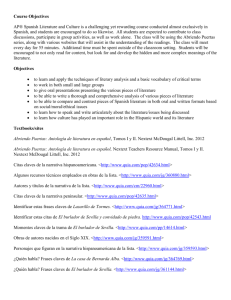File
advertisement
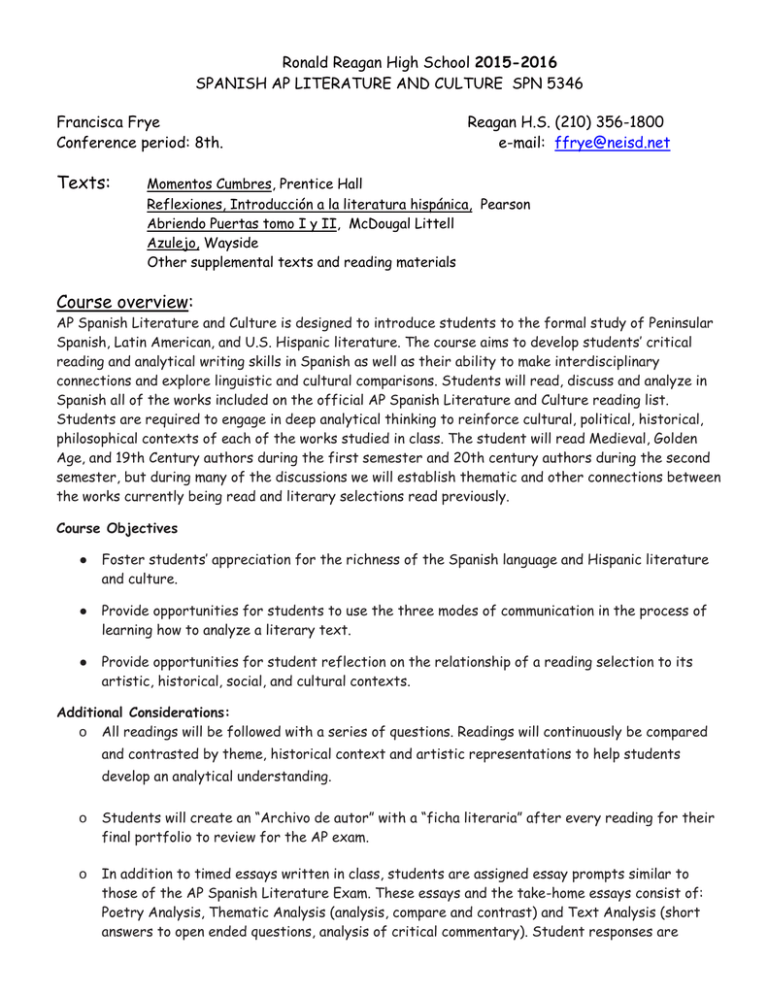
Ronald Reagan High School 2015-2016 SPANISH AP LITERATURE AND CULTURE SPN 5346 Francisca Frye Conference period: 8th. Texts: Reagan H.S. (210) 356-1800 e-mail: ffrye@neisd.net Momentos Cumbres, Prentice Hall Reflexiones, Introducción a la literatura hispánica, Pearson Abriendo Puertas tomo I y II, McDougal Littell Azulejo, Wayside Other supplemental texts and reading materials Course overview: AP Spanish Literature and Culture is designed to introduce students to the formal study of Peninsular Spanish, Latin American, and U.S. Hispanic literature. The course aims to develop students’ critical reading and analytical writing skills in Spanish as well as their ability to make interdisciplinary connections and explore linguistic and cultural comparisons. Students will read, discuss and analyze in Spanish all of the works included on the official AP Spanish Literature and Culture reading list. Students are required to engage in deep analytical thinking to reinforce cultural, political, historical, philosophical contexts of each of the works studied in class. The student will read Medieval, Golden Age, and 19th Century authors during the first semester and 20th century authors during the second semester, but during many of the discussions we will establish thematic and other connections between the works currently being read and literary selections read previously. Course Objectives ● Foster students’ appreciation for the richness of the Spanish language and Hispanic literature and culture. ● Provide opportunities for students to use the three modes of communication in the process of learning how to analyze a literary text. ● Provide opportunities for student reflection on the relationship of a reading selection to its artistic, historical, social, and cultural contexts. Additional Considerations: o All readings will be followed with a series of questions. Readings will continuously be compared and contrasted by theme, historical context and artistic representations to help students develop an analytical understanding. o Students will create an “Archivo de autor” with a “ficha literaria” after every reading for their final portfolio to review for the AP exam. o In addition to timed essays written in class, students are assigned essay prompts similar to those of the AP Spanish Literature Exam. These essays and the take-home essays consist of: Poetry Analysis, Thematic Analysis (analysis, compare and contrast) and Text Analysis (short answers to open ended questions, analysis of critical commentary). Student responses are weighted for organization, content, historical connections, analysis and language usage, following the AP scoring guidelines. o Students need to master not only the literary terms and rhetorical devices, but also make explicit connections between the devices and the overall themes represented. The three modes of communication will be emphasized throughout the year. o All spoken and written work will be presented in Spanish. Grading policy: 50% FORMAL ASSESSMENT (minimum of 6 grades) Tests / Projects - 30% Quizzes - 20 % 50% INFORMAL ASSESSMENT: (minimum of 12 grades) Homework /Class Assignments (Ongoing Evaluation) class discussions / Independent Work (Ongoing Evaluation) Tutoring is available Tuesday and Thursday morning from 8:15 – 8:40, and after school everyday by appointment. Friday (“FRYE”-day) before and after school is reserved for corrections and re-takes of tests and quizzes. Materials: ✓ Notebook binder only for Spanish ✓ Large index cards ✓ Red pen and highlighters (all colors: blue, pink, orange, yellow, green, purple) Class rules: - Students are expected to respect self and others. - Show appropriate behavior: inappropriate behavior is defined as anything you do that might interfere with: − your ability to learn − a classmate's ability to learn − my ability to teach Important Note to Parents: Films Viewed in the classroom: Films will be used as a source to complement or extend the topic at hand. Most films are foreign and do not have a rating, but all films will be edited if needed. If you have any concerns please free to email me at ffrye@neisd.net _________________________ Teacher signature Francisca Frye _________________________ Department Chair signature Marie Marks Required Reading List 1. Allende, Isabel, “Dos palabras” 2. Anónimo, “Romance de la pérdida de Alhama” 3. Anónimo, Lazarillo de Tormes (Prólogo; Tratados 1, 2, 3, 7) 4. Bécquer, Gustavo Adolfo, Rima LIII (“Volverán las oscuras golondrinas”) 5. Borges, Jorge Luis,“Borges y yo” 6. Borges, Jorge Luis, “El Sur” 7. Burgos, Julia,“A Julia de Burgos” 8. Cervantes, Miguel de, Don Quijote (Parte I, capítulos 1-5, 8 y 9; Parte II, capítulo 74) 9. Cortázar, Julio, “la noche boca arriba” 10. Cortés, Hernán,“Segunda carta de relación” (selecciones) 11. Cruz, Sor Juana Inés de la, “Hombres necios que acusáis” 12. Darío, Rubén,“A Roosevelt” 13. Don Juan Manuel, El Conde Lucanor. “Exemplo XXXV” “De lo que aconteció a un mozo que casó con una mujer muy fuerte y muy brava” 14. Dragún, Osvaldo, El hombre que se convirtió en perro 15. Fuentes, Carlos, “Chac Mool” 16. García Lorca, Federico, La casa de Bernarda Alba 17. García Lorca, Federico, “Prendimiento de Antoñito el Camborio en el camino de Sevilla” 18. García Márquez, Gabriel, “El ahogado más hermoso del mundo” 19. García Márquez, Gabriel, “La siesta del martes” 20. Garcilaso de la Vega, Soneto XXIII “En tanto que de rosa y azucena” 21. Góngora y Argote, Luis de, Soneto CLXVI “Mientras por competir con tu cabello” 22. Guillén, Nicolás,“Balada de los dos abuelos” 23. Heredia, José María, “En una tempestad” 24. León-Portilla, Miguel, Visión de los vencidos (dos secciones: “Los presagios, según los informantes de Sahagún” y “Se ha perdido el pueblo mexicatl”) 25. Machado, Antonio,“He andado muchos caminos” 26. Martí, José, “Nuestra América” 27. Montero, Rosa, “Como la vida misma” 28. Morejón, Nancy, “Mujer negra” 29. Neruda, Pablo, “Walking around” 30. Pardo Bazán, Emilia,“Las medias rojas” 31. Quevedo, Francisco de, Salmo XVII “Miré los muros de la patria mía” 32. Quiroga, Horacio, “El hijo” 33. Rivera, Tomás, …y no se lo tragó la tierra (dos capítulos: “…y no se lo tragó la tierra” y “La noche buena”) 34. Rulfo, Juan, “No oyes ladrar los perros” 35. Storni, Alfonsina, “ Peso ancestral” 36. Tirso de Molina, El burlador de Sevilla y convidado de piedra 37. Ulibarrí, Sabine, “Mi caballo mago” 38. Unamuno, Miguel de, San Manuel Bueno, mártir

